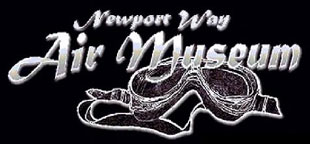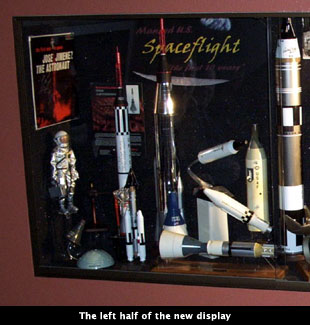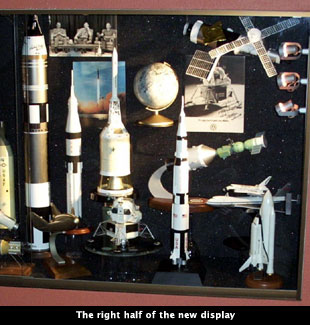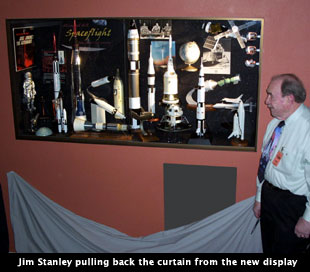|
|

|
Display space
Bringing the museum homeby Jake Schultz
Over the past few years I have been fortunate to have visited nearly 50 air and space museums. I found I enjoyed the air museum surroundings so much that I decided to recreate the décor in my home. Five years ago, when I moved into my condo in suburban Seattle, I dubbed it the "Newport Way Air Museum."

More than a nickname, I hoped that the title would inspire me to think like a curator as I acquired and displayed my collection of early aviation and manned U.S. spaceflight.
Like most collectors I initially gathered items and artifacts in a somewhat random manner. I displayed these pieces in an ever growing collection of glass cabinets from places like IKEA.
While these displays looked attractive, it was not what I really wanted and they tended to make my somewhat small condo seem even smaller. After several years of collecting, it became clear that what interested me the most were vintage models - in many cases made by or for the contractor of the actual vehicle or hardware.

By October 2002, the white carpet in my condo was really beginning to show the stains of the past several years and needed to be replaced. The remodeling gave me the opportunity to design a display for my collection starting from a clean slate.
I had been inspired by the beautiful displays at the Museum of Flight in Seattle (where I worked for about two years) and the Boeing historical display in the lobby of our main cafeteria in Seattle. It was my intention that this re-model "open up" and "warm up" my living room. I wanted to have one main cabinet - built into the wall - where I could display my selection of models depicting the first 20 years of manned U.S. spaceflight.
So with help from my roommate, off came the drywall from the main living room wall (can you say mess!). Up went new framing for the cabinet, and out came the tools to re-route the wiring and plumbing. The interior of the cabinet was lined with black "speckled" felt. I first applied a piece of sheet metal to the inside of the cabinet and then applied the felt with "Super 77" spray. This would allow me to re-arrange photos and shelves on the interior of the cabinet using magnets, without poking holes in the felt.

The cabinet was not as expensive as one might think, with the final bill approximately $1000; equivalent to the amount provded on the TV show "Trading Spaces" (glass doors $200; plywood and supplies $300; lighting and wiring $300; felt and linings $100; misc. $100). The only hired help needed was with the mudding and taping of the drywall, since a contractor could do that much better than I and in a shorter time frame.

The unveiling came February 8, and was great fun with a wonderful mix of folks in attendance. Included among the crowd was Jim Stanley, a good friend who was the first American engineer assigned to the Aerobalistics branch of the German rocket team in Huntsville, Alabama. Today, he teaches school kids as a docent at the Museum of Flight - quite a bit different than his early days of designing the Redstone rocket with Wernher von Braun.
Also attending were modeler Nick Proach, who was in town to drop off the Skylab he built for my display, as well as Boeing's lead model maker. These individuals, in addition to my other friends, made the ocassion an enjoyable venue to to share my collection with those who were knowledgeable about such things, as well as those for whom this was all relatively new.

When it came time to unveil the finished display, the lights were darkened and nearly 60 people (standing room only) gathered around. We observed a moment of silence for the loss of the Columbia crew and then all eyes were fixed on the curtain as a recording of the last 50 seconds of the Apollo 11 liftoff was played, counting down the last few seconds to liftoff. Jim Stanley cut the ribbon and the curtain dropped - the cheers from the crowd were stupendous!
So where does one go from here? I plan to fill in a few of the gaps in my collection (lunar rover, Dyna-soar, etc.) and acquire a few vintage pieces to replace some contemporary models. Currently two-thirds of the models in my collection are vintage and the remaining are either scratch built (by myself or in some cases in conjunction with friends) or commissioned by model shops due to the inability to find a vintage original. (Try to find a vintage Skylab model - good luck!)
If you are in the Seattle area and want to drop by just let me know. It's fun to share the history of space with others. So how do you display your collection?
|

© 2022 collectSPACE.com All rights reserved.
Questions? E-mail contact@collectspace.com
|
|

|
|
Jake Schultz is a kid at heart... He works as a Technical Analyst for the Boeing Company in product development - currently on the new 7E7 program. He took a two year break from Boeing recently and coordinated public programs at the Museum of Flight in Seattle. This gave Jake the opportunity to set up appearances and events with numerous aviation and space pioneers. In addition to collecting early space artifacts, Jake has spent years involved with aviation. He is a private pilot (although not actively these days), former president and officer of several EAA chapters, has completed a book on the Aerocar which is in final editing at a publisher, is a trustee on the board of the Olympic Park Institute, and serves on the board for N-Scale Magazine. Travel, antique stores, and photography are some of his other passions. Jake is single, but has yet to have one of his dates complain about his taste in decor!
|

|





